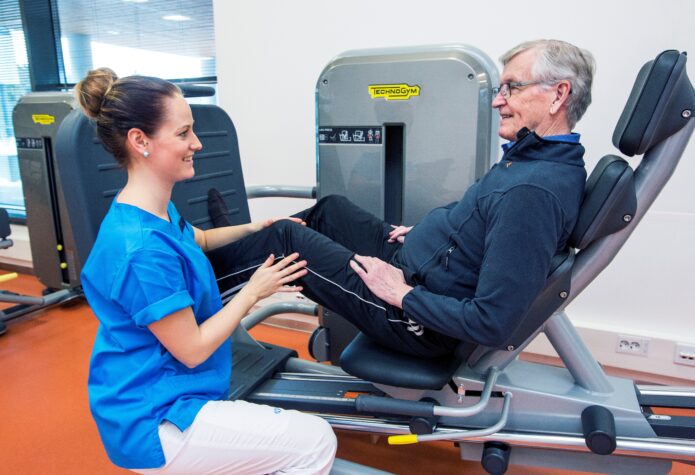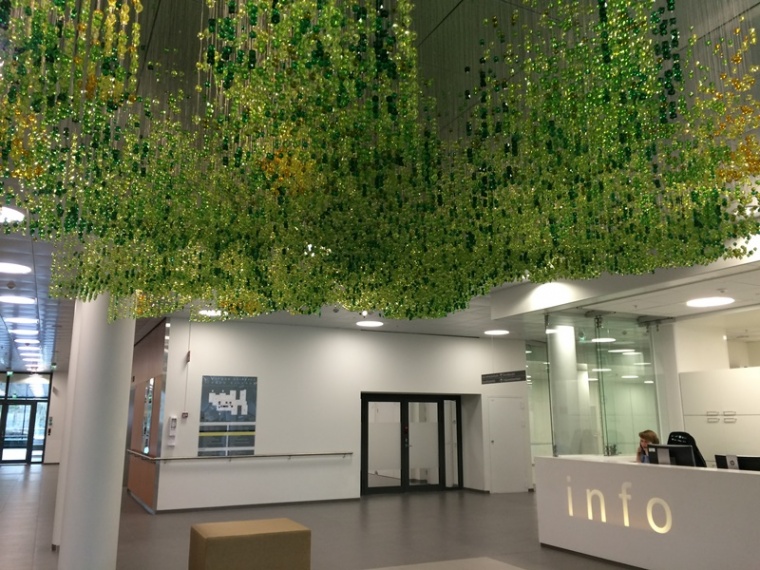Espoo new hospital: A look into the future of healthcare

Finland’s demographics are changing. The country’s ageing population is leading public health providers to look for new treatment options and ways to improve the care given at medical facilities. With its focus on patient-centred rehabilitation and home-stay support, the new Espoo hospital gives an example of what future healthcare centres in Finland may look like.
The first thing you notice when you enter the new hospital in Espoo is that it looks a bit like an art gallery. Groups of patients are gathering between paintings and sculptures displayed in bright and sunny spaces. The building hosts almost 300 pieces from the collections of the Espoo Museum of Modern Art.
Located on the Jorvi hospital campus, the brand-new facility has 270 rooms, including beds for acute and palliative care, a day clinic, a geriatric outpatient clinic and an oral healthcare unit.
After almost four years of construction, the new Espoo hospital has now welcomed its first patients this spring.
“The hospital mainly provides post-acute care for elderly people”, explains Tero Vainio, the responsible project manager for the municipality of Espoo. “It offers both orthopaedic and neurological rehabilitation, as well as psychogeriatric treatment and treatment of infectious diseases.”
The building was co-financed with a EUR 75 million loan from NIB, and is one of the municipality’s largest infrastructure investments to date. The total project cost came to EUR 150 million.
With about 270,000 inhabitants, Espoo is Finland’s second-largest city. The increasing life expectancy in the country and the rise in related chronic illnesses have made significant long-term investments in healthcare necessary.

Hanging glass bead sculpture by Finnish artist Hanna Vihriälä.
New treatment in a new environment
Many of Finland’s public hospitals were built in the 1960s and 70s. Some of the facilities still reflect the treatment practices of a bygone era, and while the idea behind the new facility in Espoo is not a novel one, it still represents a turning point.
“There are not many healthcare facilities in Finland that specialise in rehabilitation”, says Mr. Vainio. “The treatment that the Espoo hospital offers highlights the patient’s active role in his or her own recovery, as well as the role of family support, and the importance of being able to return to one’s own home.”
“Further, the aim is to enable ageing patients to live independently as long as possible, so outpatient clinics and home-stay support services are provided”, he explains.
“All rooms are designed for single patients to ensure privacy and rest. This has been proven to lower the risk of hospital-acquired infections and reduce the length of patients’ stays. However, activities are all team-based to support social rehabilitation. Family members and friends may participate, along with personal coaches.”
The architecture of the building tries to incorporate both art and nature, which is intended to support the recovery process.
“Common areas are designed to be bright and enjoyable to motivate people to leave their private rooms”, says Mr Vainio. “The artworks we display support this idea.”
Designing a hospital
Hospitals are complex, adaptive human systems, which makes them challenging design tasks. The building needs to take into account requirements for treatment efficiency and patients’ individual needs.
“Because we share infrastructure and support services with Jorvi Hospital, we can offer integrated treatment models”, Mr. Vainio explains. “After receiving surgery at Jorvi, patients can be transferred directly to the new facility for subsequent treatment.”
Previously, rehabilitation and post-acute treatment services were scattered across three different hospitals in other locations, which represented a logistical challenge for staff and patients alike. The bundling of services is intended to make treatment more accessible.
“Patient flows are now set up to be as fluid as possible. Integrated services increase the quality of care and the economic results.”
An element of social cohesion
The municipality of Espoo has identified the new hospital as an aspect of sustainable urban development, since the provision of healthcare and related social services across municipal and organisational boundaries will support social integration.
Further, the facility utilises a new type of renewable energy supply that links its output to the grid.
“The building has a two-way energy production system for heating and cooling. The excess heat generated by the hospital will be used for district heating”, says Mr. Vainio.
While the often-unexpected evolution of technology makes it difficult to predict what the hospital of the future will look like, the new facility in Espoo was an important step to establishing hospital care in Finland as an element of social cohesion, and to promote a new way of thinking about post-acute treatment and care.
